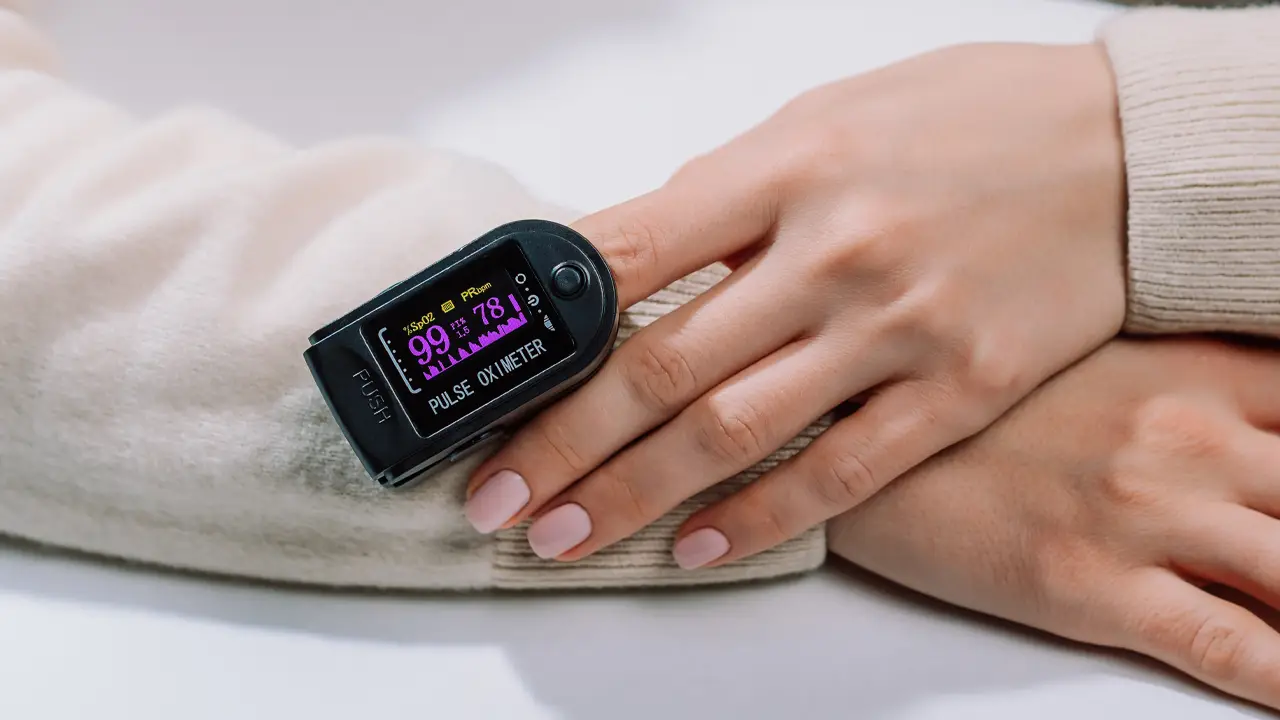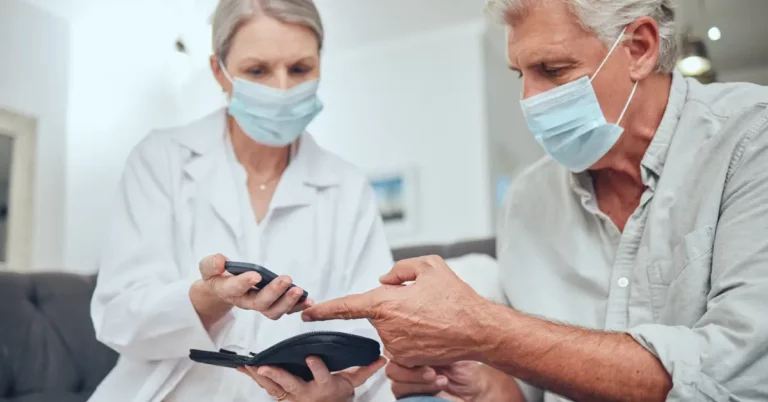A pulse oximeter is a small, portable device that measures the oxygen saturation level in your blood and your pulse rate. Monitoring your blood oxygen level is important, especially for those with certain health conditions such as COPD, or those who live at high altitudes. It can also be useful for people who have recently recovered from COVID-19, or those who suspect they may have contracted the virus.
In this step-by-step guide, we will explain how to use a pulse oximeter, including tips for getting the most accurate readings and interpreting the results. With this guide, you can use a pulse oximeter at home for wellness and early detection of potential health issues.
Understanding Pulse Oximetry
Pulse oximetry is a non-invasive and painless way to measure the amount of oxygen in your blood, also known as oxygen saturation. Typically, a healthy oxygen saturation level falls between 95-100%. Sometimes a healthcare provider may use pulse oximetry to monitor your oxygen levels.
You can also use a pulse oximeter at home to measure your oxygen saturation level. The device works by shining a beam of light through your finger, toe, or earlobe to measure the amount of oxygen in your blood. It also measures your heart rate by detecting the changes in blood volume with each heartbeat.
It’s important to note that while pulse oximeters are useful for estimating blood oxygen levels, they may not always display accurate readings. For example, if you have certain health problems such as poor circulation, the measurements may not be as accurate. Additionally, pulse oximeters are not a substitute for medical evaluation, and should not replace the advice of a healthcare provider.
During the coronavirus pandemic, pulse oximeters have become more popular for home use. If you choose to use one, it’s recommended to measure your oxygen saturation level at least three times a day, at the same times of day. This can help you evaluate any changes in your oxygen levels over time. However, regardless of what your pulse oximeter readings may be, if you experience any symptoms or have any concerns about your health, it’s always important to contact your healthcare provider.
How to Use a Pulse Oximeter
- Choose a device: Pulse oximeters are widely available for purchase online or in medical supply stores. There are many different models available, so it’s important to choose one that is easy to use and provides accurate readings. Your healthcare provider may also recommend a specific device.
- Prepare the device: Most pulse oximeters are small and portable, and they usually require batteries to operate. Make sure the device is turned on and that the batteries are charged or replaced if necessary.
- Position the device: Place the device on your finger or other body part, following the manufacturer’s instructions. If using your finger, make sure the clip is securely attached to your fingertip and that your nail is not obstructing the sensor. You may need to switch to a different finger if you are not getting a good reading.
- Warm your hand: If your hands are cold, you may need to warm them up by rubbing them together or holding them under warm water for a few minutes. Cold hands can cause inaccurate readings.
- Keep the device in place: Hold your hand still and keep the pulse oximeter in place for at least 10-15 seconds or until the reading stabilizes. Some devices may take longer to measure and provide a stable reading.
- Read the results: The pulse oximeter will display your oxygen saturation level and pulse rate. If your oxygen saturation level is lower than 95%, it may indicate low oxygen levels in your blood, which could be a sign of lung problems or other health issues. Your doctor may suggest checking your oxygen saturation level regularly if you have certain health conditions.
- Keep a record: Keep a diary of your readings, including the date, time, and the results. This can be useful for tracking changes in your oxygen saturation level over time and for sharing with your healthcare provider.
It’s important to note that pulse oximeters are not a substitute for medical advice or treatment. If you have concerns about your health, always consult with your healthcare provider.
Additional Considerations
- Nail polish or artificial nails: According to studies, if you have nail polish or artificial nails, they may interfere with the pulse oximeter’s readings. It’s recommended to remove anything obstructing your nails before using the device to help ensure accurate readings.
- Altitude: If you are at a high altitude, your oxygen saturation level may be lower than normal due to the decreased oxygen in the air. It’s important to keep this in mind when interpreting your readings.
- COVID-19: The COVID-19 pandemic has led to an increased interest in pulse oximeters, as low oxygen levels can be a sign of severe COVID-19 illness. However, it’s important to note that a normal oxygen saturation level does not necessarily mean you do not have COVID-19, and a low oxygen saturation level may not always be a sign of COVID-19.
- Consult your healthcare provider: Your doctor may recommend using a pulse oximeter at home to monitor certain health conditions. However, it’s important to consult with your healthcare provider before using a pulse oximeter and to follow their instructions for use.
- Accuracy of readings: While pulse oximeters are generally considered to be accurate, there are factors that can affect the accuracy of the readings, such as poor circulation or movement during use. It’s important to use the device correctly and to understand that the readings are estimates and not a substitute for medical advice or treatment.
- Monitoring drops below 95%: Your doctor may advise you to monitor your oxygen saturation level regularly and to call for help if it drops below 95%. This is especially important if you have certain health conditions or if you experience symptoms such as shortness of breath or chest pain.
Using Pulse Oximeters from DrKumo Remote Patient Monitoring
DrKumo is a technology leader in providing highly scalable, continuous, real-time remote patient monitoring solutions for chronic disease management, acute care, post-operation, and hospital care at home. One of the many tools that DrKumo provides is the pulse oximeter, a device used to measure oxygen saturation in the blood. The pulse oximeter is integrated into DrKumo remote patient monitoring (RPM) technology, which enables patients to manage their health conditions in the comfort of their homes while providing healthcare providers with real-time intelligence for timely intervention. DrKumo also has friendly employees ready to assist patients use medical devices.
DrKumo user-friendly solution is powered by state-of-the-art, HIPAA-compliant, mobile-enabled, continuous real-time monitoring, and AI/ML engine. Alongside the advanced technology, DrKumo employees are always ready to aid in the use of the devices, ensuring that patients and healthcare providers get the most out of the RPM technology.
With an innovative, collaborative, and technology-driven culture, DrKumo is revolutionizing the way people access quality healthcare across the world. The effective solutions that DrKumo provides to both patients and healthcare providers are the result of the company’s commitment to improving healthcare through technology.
Takeaways
A pulse oximeter is a useful device that can help you monitor your oxygen saturation level and pulse rate. By understanding how to use a pulse oximeter correctly and taking into consideration additional factors that can affect the accuracy of the readings, you can use the device to monitor your health at home or as advised by your healthcare provider. However, it’s important to remember that the pulse oximeter readings are estimates, and not a substitute for professional medical advice or treatment. If you have any concerns about your health, it’s always best to consult with your healthcare provider.
Take control of your health and explore the benefits of RPM technology, including the use of a pulse oximeter, to monitor your blood oxygen levels from the comfort of your own home. Contact DrKumo now.
Disclaimer: It’s important to note that while this guide provides information on how to use a pulse oximeter, the information is not a substitute for medical advice or treatment. Healthwise, the company that provides the information for this guide disclaims any warranty or liability for your use of this information.








